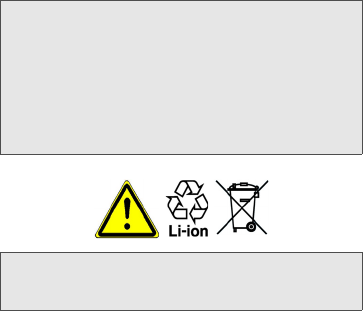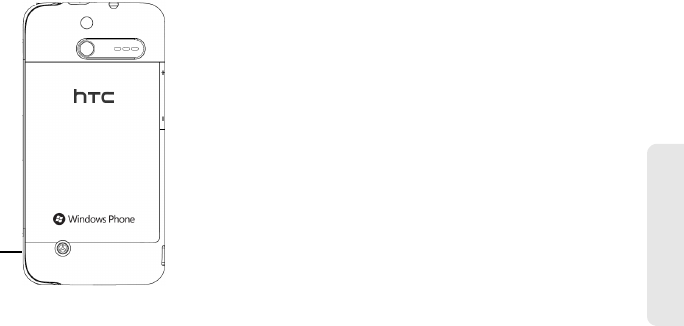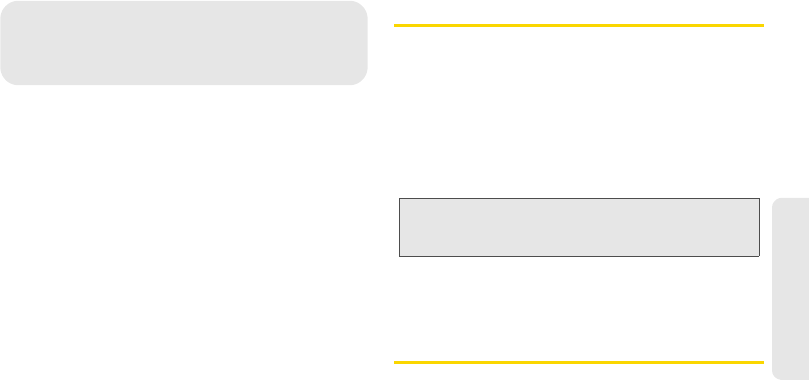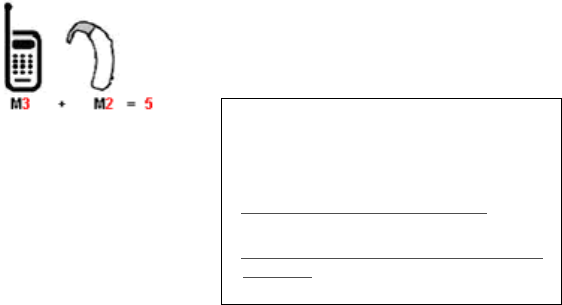HTC PC93100 Windows Phone User Manual Gold Certification
HTC Corporation Windows Phone Gold Certification
HTC >
Contents
- 1. User Manual 1 of 2
- 2. user manual 2 of 2
- 3. user manual 1 of 2
user manual 2 of 2

Safety and Warranty
Information
2

Important Safety Information 3
Important Safety Information
ࡗImportant Health Information and Safety Precautions
(page 3)
ࡗGeneral Precautions (page 10)
ࡗAdditional Safety Information (page 13)
This User Guide contains important operational and
safety information that will help you safely use your
device. Failure to read and follow the information
provided in this guide may result in serious bodily
injury, death, or property damage.
Important Health Information and
Safety Precautions
When using this product, the safety precautions below
must be taken to avoid possible legal liabilities and
damages.
Retain and follow all product safety and operating
instructions. Observe all warnings in the operating
instructions on the product.
To reduce the risk of bodily injury, electric shock, fire,
and damage to the equipment, observe the following
precautions.
Electrical Safety
This product is intended for use when supplied with
power from the designated battery or power supply
unit. Other usage may be dangerous and will invalidate
any approval given to this product.
Safety Precautions for Proper Grounding
Installation
CAUTION: Connecting to an improperly grounded
equipment can result in an electric shock to your
device.
This product is equipped with a USB cable for
connecting with desktop or notebook computer. Be
sure your computer is properly grounded (earthed)
before connecting this product to the computer. The
Important Safety Information

4 Important Safety Information
power supply cord of a desktop or notebook computer
has an equipment-grounding conductor and a
grounding plug. The plug must be plugged into an
appropriate outlet which is properly installed and
grounded in accordance with all local codes and
ordinances.
Safety Precautions for Power Supply Unit
ⅷUse the correct external power source
A product should be operated only from the type
of power source indicated on the electrical
ratings label. If you are not sure of the type of
power source required, consult your authorized
service provider or local power company. For a
product that operates from battery power or
other sources, refer to the operating instructions
that are included with the product.
This product should be operated only with the
following designated power supply unit(s).
AC Adapter HTC, Model TC U250
ⅷHandle battery packs carefully
This product contains a Lithium-ion polymer or
Lithium-ion battery. There is a risk of fire and
burns if the battery pack is handled improperly.
Do not attempt to open or service the battery
pack. Do not disassemble, crush, puncture,
short external contacts or circuits, dispose of in
fire or water, or expose a battery pack to
temperatures higher than 140°F (60°C).
WARNING: There is a danger of explosion if the battery is
incorrectly replaced. To reduce risk of fire or
burns, do not disassemble, crush, puncture, short
external contacts, expose to temperature above
60°C (140°F), or dispose of in fire or water.
Replace only with specified batteries. Recycle or
dispose of used batteries according to the local
regulations or reference guide supplied with your
product.
Note: This product should be operated only with the following
designated Battery Pack(s).
HTC, Model RHOD160.

Important Safety Information 5
Important Safety Information
Take Extra Precautions
ⅷKeep the battery or device dry and away from water
or any liquid as it may cause a short circuit.
ⅷKeep metal objects away so they don’t come in
contact with the battery or its connectors as it may
lead to short circuit during operation.
ⅷThe phone should only be connected to products
that bear the USB-IF logo or have completed the
USB-IF compliance program.
ⅷDo not use a battery that appears damaged,
deformed, or discolored, or the one that has any rust
on its casing, overheats, or emits a foul odor.
ⅷAlways keep the battery out of the reach of babies
and small children, to avoid swallowing of the battery.
Consult the doctor immediately if the battery is
swallowed.
ⅷOnly use the battery with a charging system that has
been qualified with the system per this standard,
IEEE-Std-1725-2006. Use of an unqualified battery or
charger may present a risk of fire, explosion, leakage
or other hazard.
ⅷReplace the battery only with another battery that has
been qualified with the system per this standard,
IEEE-Std-1725-2006. Use of an unqualified battery
may present a risk of fire, explosion, leakage or other
hazard.
ⅷAvoid dropping the phone or battery. If the phone or
battery is dropped, especially on a hard surface, and
the user suspects damage, take it to a service centre
for inspection.
ⅷIf the battery leaks:
ⅢDo not allow the leaking fluid to come in contact
with skin or clothing. If already in contact, flush the
affected area immediately with clean water and
seek medical advice.
6 Important Safety Information
ⅢDo not allow the leaking fluid to come in contact
with eyes. If already in contact, DO NOT rub; rinse
with clean water immediately and seek medical
advice.
ⅢTake extra precautions to keep a leaking battery
away from fire as there is a danger of ignition or
explosion.
Safety Precautions for Direct Sunlight
Keep this product away from excessive moisture and
extreme temperatures. Do not leave the product or its
battery inside a vehicle or in places where the
temperature may exceed 60°C (140°F), such as on a
car dashboard, window sill, or behind a glass that is
exposed to direct sunlight or strong ultraviolet light for
extended periods of time. This may damage the
product, overheat the battery, or pose a risk to the
vehicle.
Prevention of Hearing Loss
CAUTION: Permanent hearing loss may occur if
earphones or headphones are used at high volume for
prolonged periods of time.
Safety in Aircraft
Due to the possible interference caused by this product
to an aircraft’s navigation system and its
communications network, using this device’s phone
function on board an airplane is against the law in
most countries. If you want to use this device when on
board an aircraft, remember to turn off your phone by
switching to airplane mode.
Environment Restrictions
Do not use this product in gas stations, fuel depots,
chemical plants or where blasting operations are in
progress, or in potentially explosive atmospheres such
as fuelling areas, fuel storehouses, below deck on
boats, chemical plants, fuel or chemical transfer or
storage facilities, and areas where the air contains
chemicals or particles, such as grain, dust, or metal
powders. Please be aware that sparks in such areas
could cause an explosion or fire resulting in bodily
injury or even death.

Important Safety Information 7
Important Safety Information
Explosive Atmospheres
When in any area with a potentially explosive
atmosphere or where flammable materials exist, the
product should be turned off and the user should obey
all signs and instructions. Sparks in such areas could
cause an explosion or fire resulting in bodily injury or
even death. Users are advised not to use the
equipment at refueling points such as service or gas
stations, and are reminded of the need to observe
restrictions on the use of radio equipment in fuel
depots, chemical plants, or where blasting operations
are in progress. Areas with a potentially explosive
atmosphere are often, but not always, clearly marked.
These include fueling areas, below deck on boats, fuel
or chemical transfer or storage facilities, and areas
where the air contains chemicals or particles, such as
grain, dust, or metal powders.
Road Safety
Full attention must be given to driving at all times in
order to reduce the risk of an accident. Using a phone
while driving (even with a hands free kit) causes
distraction and can lead to an accident. You must
comply with local laws and regulations restricting the
use of wireless devices while driving.
Safety Precautions for RF Exposure
ⅷAvoid using your phone near metal structures (for
example, the steel frame of a building).
ⅷAvoid using your phone near strong electromagnetic
sources, such as microwave ovens, sound speakers,
TV and radio.
ⅷUse only original manufacturer-approved
accessories, or accessories that do not contain any
metal.
ⅷUse of non-original manufacturer-approved
accessories may violate your local RF exposure
guidelines and should be avoided.
Interference with Medical Equipment
Functions
This product may cause medical equipment to
malfunction. The use of this device is forbidden in most
hospitals and medical clinics.
8 Important Safety Information
If you use any other personal medical device, consult
the manufacturer of your device to determine if they are
adequately shielded from external RF energy. Your
physician may be able to assist you in obtaining this
information.
Turn your phone OFF in health care facilities when any
regulations posted in these areas instruct you to do so.
Hospitals or health care facilities may be using
equipment that could be sensitive to external RF
energy.
Hearing Aids
Some digital wireless phones may interfere with some
hearing aids. In the event of such interference, you may
want to consult your service provider, or call the
customer service line to discuss alternatives.
Nonionizing Radiation
Your device has an internal antenna. This product
should be operated in its normal-use position to ensure
the radiative performance and safety of the
interference. As with other mobile radio transmitting
equipment, users are advised that for satisfactory
operation of the equipment and for the safety of
personnel, it is recommended that no part of the
human body be allowed to come too close to the
antenna during operation of the equipment.
Use only the supplied integral antenna. Use of
unauthorized or modified antennas may impair call
quality and damage the phone, causing loss of
performance and SAR levels exceeding the
recommended limits as well as result in non-
compliance with local regulatory requirements in your
country.
To assure optimal phone performance and ensure
human exposure to RF energy is within the guidelines
set forth in the relevant standards, always use your
device only in its normal-use position. Contact with the
antenna area may impair call quality and cause your
device to operate at a higher power level than needed.

Important Safety Information 9
Important Safety Information
Avoiding contact with the antenna area when the
phone is IN USE optimizes the antenna performance
and the battery life.
Electrical Safety
ⅷAccessories
ⅢUse only approved accessories.
ⅢDo not connect with incompatible products or
accessories.
ⅢTake care not to touch or allow metal objects,
such as coins or key rings, to contact or short-
circuit the battery terminals.
ⅷConnection to a car
Seek professional advice when connecting a
phone interface to the vehicle electrical system.
ⅷFaulty and damaged products
ⅢDo not attempt to disassemble the device or its
accessories.
ⅢOnly qualified personnel should service or repair
the device or its accessories.
Antenna
location

10 Important Safety Information
General Precautions
You alone are responsible for how you use your phone
and any consequences of its use. You must always
switch off your phone wherever the use of a phone is
prohibited. Use of your phone is subject to safety
measures designed to protect users and their
environment.
ⅷAvoid applying excessive pressure to the device.
Do not apply excessive pressure on the screen
and the device to prevent damaging them and
remove the device from your pants’ pocket
before sitting down. It is also recommended that
you store the device in a protective case and
only use the device stylus or your finger when
interacting with the touch screen. Cracked
display screens due to improper handling are
not covered by the warranty.
ⅷDevice getting warm after prolonged use.
When using your device for prolonged periods
of time, such as when you’re talking on the
phone, charging the battery or browsing the
Web, the device may become warm. In most
cases, this condition is normal and therefore
should not be interpreted as a problem with the
device.
ⅷHeed service markings.
Except as explained elsewhere in the Operating
or Service documentation, do not service any
product yourself. Service needed on
components inside the device should be done
by an authorized service technician or provider.
ⅷProtect your phone.
ⅢAlways treat your phone and its accessories with
care and keep them in a clean and dust-free
place.
ⅢDo not expose your phone or its accessories to
open flames or lit tobacco products.
ⅢDo not expose your phone or its accessories to
liquid, moisture or high humidity.
ⅢDo not drop, throw or try to bend your phone or
its accessories.
ⅢDo not use harsh chemicals, cleaning solvents, or
aerosols to clean the device or its accessories.
ⅢDo not paint your phone or its accessories.
ⅢDo not attempt to disassemble your phone or its
accessories, only authorized personnel must do
so.

Important Safety Information 11
Important Safety Information
ⅢDo not expose your phone or its accessories to
extreme temperatures, minimum -4°F (-20°C) and
maximum 122°F (50°C).
ⅢPlease check local regulations for disposal of
electronic products.
ⅢDo not carry your phone in your back pocket as it
could break when you sit down.
ⅷSend the product for service.
Unplug the product from the electrical outlet and
refer servicing to an authorized service
technician or provider under the following
conditions:
ⅢLiquid has been spilled or an object has fallen
into the product.
ⅢThe product has been exposed to rain or water.
ⅢThe product has been dropped or damaged.
ⅢThere are noticeable signs of overheating.
ⅢThe product does not operate normally when you
follow the operating instructions.
ⅷAvoid operating the product in hot areas.
The product should be placed away from heat
sources such as radiators, heat registers, stoves,
or other products (including amplifiers) that
produce heat.
ⅷAvoid operating the product in wet areas.
Never use the product in a wet location.
ⅷAvoid using your device after a dramatic change in
temperature.
When you move your device between
environments with very different temperature
and/or humidity ranges, condensation may form
on or within the device. To avoid damaging the
device, allow sufficient time for the moisture to
evaporate before using the device.
NOTICE: When taking the device from low-
temperature conditions into a warmer
environment or from high-temperature
conditions into a cooler environment, allow the
device to acclimate to room temperature before
turning on power.
ⅷAvoid pushing objects into product.
Never push objects of any kind into cabinet slots
or other openings in the product. Slots and
openings are provided for ventilation. These
openings must not be blocked or covered.
12 Important Safety Information
ⅷAvoid placing device near air bags.
Do not place a phone in the area over an air
bag or in the air bag deployment area. Store the
phone safely before driving your vehicle.
ⅷUse only manufacturer-approved mounting
accessories.
Do not use the product on an unstable table,
cart, stand, tripod, or bracket. Any mounting of
the product should follow the manufacturer’s
instructions, and should use a mounting
accessory recommended by the manufacturer.
ⅷAvoid unstable mounting.
Do not place the product with an unstable base.
ⅷUse only manufacturer-approved equipment.
This product should be used only with personal
computers and options identified as suitable for
use with your equipment.
ⅷAdjust the volume before using headphones.
Turn down the volume before using
headphones or other audio devices.
ⅷClean the product.
Unplug the product from the wall outlet before
cleaning. Do not use liquid cleaners or aerosol
cleaners. Use a damp cloth for cleaning, but
NEVER use water to clean the LCD screen.
ⅷKeep the product out of reach of small children.
Do not leave your phone and its accessories
within the reach of small children or allow them
to play with it. They could hurt themselves or
others, or could accidentally damage the phone.
Your phone contains small parts with sharp
edges that may cause an injury or which could
become detached and create a choking hazard.
ⅷAvoid repetitive motion injuries.
To minimise the risk of RSI, when texting or
playing games with your phone:
ⅢDo not grip the phone too tightly
ⅢPress the buttons lightly
ⅢMake use of the special features in the handset
which minimise the number of buttons which
have to be pressed, such as message templates
and predictive text.
ⅢTake lots of breaks to stretch and relax.
ⅷBe attentive when operating machinery.
Full attention must be given to operating the
machinery in order to reduce the risk of an
accident.

Important Safety Information 13
Important Safety Information
ⅷProduct produces loud noise.
This phone is capable of producing loud noises
which may damage your hearing.
ⅷUsing the product during emergencies.
This phone, like any wireless phone, operates
using radio signals, which cannot guarantee
connection in all conditions. Therefore, you must
never rely solely on any wireless phone for
emergency communications.
Additional Safety Information
Do Not Use the PC Functions of Your Device
While Driving or Walking
Never use the personal computer functions of your
device while driving an automobile or any other
moving vehicle. Always pull out of traffic and come to a
stop in a legally permissible and safe location before
using your device. Failure to do so could result in
serious bodily injury in a traffic accident.
When driving:
ⅷNever place your device on the passenger seat or
anyplace else in the car where it can become a
projectile during a collision or stop.
ⅷAn air bag inflates with great force. DO NOT place
objects, including either installed or portable wireless
equipment, in the area over the air bag or in the air
bag deployment area. If in-vehicle wireless
equipment is improperly installed and the air bag
inflates, serious injury could result.
Never store or transport flammable liquids, gases or
explosive materials in the same compartment of your
automobile as the device or any of its accessories, as
possible sparking in the device could cause ignition or
explosion.
Never use your device while walking. Usage while
walking could result in bodily injury caused by
inattention to automobile traffic or other pedestrian
hazards.

14 Important Safety Information
Using The Phone While Driving Is Extremely
Dangerous
Talking on or using your device while driving is
extremely dangerous and is illegal in some states.
Remember, safety comes first. Check the laws and
regulations on the use of phones in the areas where
you drive. Always obey them.
If you must use the phone function while driving,
please:
ⅷGive full attention to driving. Driving safely is your first
responsibility.
ⅷUse hands-free operation or one-touch, speed
dialing, and auto answer modes.
ⅷPull off the road and park before making or
answering a call.
When Using Your Device Near Other
Electronic Devices
Your wireless handheld portable device is a low power
radio transmitter and receiver. When it is ON, it receives
and also sends out radio frequency (RF) signals.
Most modern electronic equipment is shielded from RF
energy. However, certain electronic equipment may not
be shielded against the RF signals from your wireless
device; therefore, use of your device must be restricted
in certain situations.
In addition, the computer portion of your device
produces low levels of RF energy due to the generation
of digital timing pulses by its clock oscillator circuits.
Your device has been equipped with internal shielding
to minimize stray emissions of RF energy. However, use
of the computer functions of your device must be
restricted in certain situations.
Hearing Aids
Some digital wireless phones may interfere with some
hearing aids. In the event of such interference, you may
want to consult your service provider, or call the
customer service line to discuss alternatives.
WARNING: Failure to follow these instructions could lead to
serious personal injury and possible property
damage.

Important Safety Information 15
Important Safety Information
Electronic Devices in Vehicles
RF signals may affect improperly installed or
inadequately shielded electronic systems in motor
vehicles. Check with the manufacturer or its
representative regarding your vehicle. You should also
consult the manufacturer of any equipment that has
been added to your vehicle.
Posted Facilities
Turn your device OFF where posted notices so require.
Turn Off Your Device Before Flying
Aircraft
FCC regulations prohibit using the transmitting and
phone functions of your device while in the air. In
addition, most airline regulations prohibit the on-board
use of portable PCs (and all other portable electronic
devices that could potentially emit stray RF energy),
particularly during take-offs and landings, to prevent
any possible interference with the reception of signals
by airborne electronic navigational devices.
Turn your device OFF before boarding an aircraft.
Always request and obtain prior consent and approval
of an authorized airline representative before using
your device aboard an aircraft. Always follow the
instructions of the airline representative whenever using
your device aboard an aircraft, to prevent any possible
interference with airborne electronic equipment.
Turn Off Your Device in Dangerous Areas
Blasting Areas
To avoid interfering with blasting operations, turn your
device OFF when in a “blasting area” or in areas
posted “Turn off two-way radio.” Obey all signs and
instructions.
Potentially Explosive Atmospheres
Turn your device OFF when in any area with a
potentially explosive atmosphere and obey all signs
and instructions. Sparks in such areas could cause an
explosion or fire resulting in bodily injury or even death.
Areas with a potentially explosive atmosphere are often,
but not always, clearly marked. They include fueling
areas such as gas stations; below deck on boats; fuel
or chemical transfer or storage facilities; vehicles using
liquefied petroleum gas (such as propane or butane);
16 Important Safety Information
areas where the air contains chemicals or articles, such
as grain, dust, or metal powders; and any other area
where you would normally be advised to turn off your
vehicle’s engine.
General Safety and Other Precautions
Your device is a high quality piece of equipment.
Before operating, read all instructions and cautionary
markings on the product, battery and AC phone
charger.
Failure to follow the directions below could result in
serious bodily injury or property damage due to battery
liquid leakage, fire or rupture.
DO NOT use or store this equipment in a place where it
will be exposed to high temperatures, such as near an
open flame or heat-emitting equipment.
DO NOT drop your device or subject it to severe shock.
When not using, lay down the unit to avoid possible
damage due to instability.
DO NOT expose this equipment to rain or spilled
beverages.
DO NOT use unauthorized accessories.
DO NOT disassemble the device or its accessories. If
service or repair is required, return unit to an authorized
service center. If the unit is disassembled, the risk of
electric shock or fire may result.
Never allow metallic objects, such as staples and
paper clips, to get into the inside of your device.
Never touch the liquid that might leak from a broken
liquid crystal display. Contact with this liquid could
cause a skin rash. If the crystal display liquid should
come into contact with the skin or clothing, wash it
immediately with clean water.
In the event that the device emits an unusual odor or
sound or generates smoke, immediately disconnect
the AC phone charger from the power outlet, and then
detach the battery.
Antenna Safety
Use only the supplied or an approved replacement
antenna. Unauthorized antennas, modifications, or
attachments could impair call quality, damage your
device, or result in violation of FCC regulations. Please
contact your local dealer for replacement antenna.

Important Safety Information 17
Important Safety Information
Do not use the device with a damaged antenna. If a
damaged antenna comes into contact with the skin, a
minor burn may result. Please contact your local dealer
for replacement antenna.
Battery Safety
Your device uses a removable and rechargeable
lithium ion battery. Please contact customer service for
assistance should you need a replacement battery.
DOs
ⅷOnly use the battery and charger approved by the
manufacturer.
ⅷOnly use the battery for its original purpose.
ⅷTry to keep batteries at a temperature between 41°F
(5°C) and 95°F (35°C).
ⅷIf the battery is stored in temperatures above or
below the recommended range, give it time to warm
up or cool down before using.
ⅷCompletely drain the battery before recharging. It
may take one to four days to completely drain.
ⅷStore the discharged battery in a cool, dark, and dry
place.
ⅷPurchase a new battery when its operating time
gradually decreases after fully charging.
ⅷProperly dispose of the battery according to local
regulations.
DON’Ts
ⅷDon’t attempt to disassemble the battery – it is a
sealed unit with no serviceable parts.
ⅷDon’t expose the battery terminals to any other metal
object (e.g., by carrying it in your pocket or purse
with other metallic objects such as coins, clips and
pens). This can short circuit and critically damage
the battery.
ⅷDon’t leave the battery in hot or cold temps.
Otherwise, it could significantly reduce the capacity
and lifetime of the battery.
ⅷDon’t dispose of the battery into a fire.
Lithium ion batteries are recyclable. When you replace
the removable battery, please request the repair center
to recycle the battery in accordance with RBRC
standards. When disposing of the battery by yourself,
please call RBRC at (800) 822-8837 for proper
disposal tips.
18 Important Safety Information
Never touch any fluid that might leak from the built-in
battery. Such liquid when in contact with the eyes or
skin, could cause injury to the skin or eyes. Should the
liquid come into contact with the eyes, irrigate the eyes
thoroughly with clean water and immediately seek
medical attention. In the event the liquid comes into
contact with the skin or clothing, wash it away
immediately with clean water.
AC Phone Charger
Use the Correct External Power Source
A product should be operated only from the type of
power source indicated on the electrical ratings label. If
you are not sure of the type of power source required,
consult your authorized service provider or local power
company. For a product that operates from battery
power or other sources, refer to the operating
instructions that are included with the product.
The AC phone charger designed by the manufacturer
for this unit requires the use of a standard 120 V AC
power source for device operation.
Never attempt to disassemble or repair an AC phone
charger. Never use an AC phone charger if it has a
damaged or worn power cord or plug. Always contact
an authorized service center if repair or replacement is
required.
Never alter the AC cord or plug on an AC phone
charger. If the plug will not fit into the available outlet,
have a proper outlet installed by a qualified electrician.
Never allow any liquids or water to spill on an AC
phone charger when it is connected to an AC power
source.
Always use the manufacturer-authorized AC phone
charger to avoid any risk of bodily injury or damage to
your cellular phone or battery.
Never attempt to connect or disconnect the AC phone
charger with wet hands. Always unplug the AC phone
charger from the power source before attempting any
cleaning. Always use a soft cloth dampened with water
to clean the equipment, after it has been unplugged.
Handling the cord on this product or cords associated
with accessories sold with this product, will expose you
to lead, a chemical known to the State of California to

Important Safety Information 19
Important Safety Information
cause birth defects or other reproductive harm. Wash
hands after handling.
Always disconnect the travel charger or desktop
charger from the power source when it is not in use.
20 Important Safety Information

Regulatory Notices 21
Regulatory Notices
s
ࡗRegulatory Agency Identifications (page 21)
ࡗFederal Communication Commission Interference
Statement (page 21)
ࡗSAR Information (page 25)
ࡗTelecommunications & Internet Association (TIA) Safety
Information (page 26)
ࡗWEEE Notice (page 27)
ࡗRoHS Compliance (page 28)
This section provides more safety information and
regulation statement for using your device.
Regulatory Agency Identifications
For regulatory identification purposes, your product is
assigned a model number of PC93100.
To ensure continued reliable and safe operation of your
device, use only the accessories listed below with your
PC93100.
The Battery Pack has been assigned a model number
of RHOD160. Operating temperature range: 32°F to
104°F (0°C to 40°C)
Federal Communication
Commission Interference
Statement
This equipment has been tested and found to comply
with the limits for a Class B digital device, pursuant to
Part 15 of the FCC Rules. These limits are designed to
provide reasonable protection against harmful
Regulatory Notices
Note: This product is intended for use with a certified Class 2
Limited Power Source, rated 5 Volts DC, maximum 1
Amp power supply unit.
22 Regulatory Notices
interference in a residential installation. This equipment
generates, uses and can radiate radio frequency
energy and, if not installed and used in accordance
with the instructions, may cause harmful interference to
radio communications. However, there is no guarantee
that interference will not occur in a particular
installation. If this equipment does cause harmful
interference to radio or television reception, which can
be determined by turning the equipment off and on,
the user is encouraged to try to correct the interference
by one of the following measures:
ⅷReorient or relocate the receiving antenna.
ⅷIncrease the separation between the equipment and
receiver.
ⅷConnect the equipment into an outlet on a circuit
different from that to which the receiver is connected.
ⅷConsult the dealer or an experienced radio or
television technician for help.
FCC Caution: Any changes or modifications not
expressly approved by the party responsible for
compliance could void the user’s authority to operate
this equipment.
This device complies with Part 15 of the FCC Rules.
Operation is subject to the following two conditions: (1)
This device may not cause harmful interference, and
(2) this device must accept any interference received,
including interference that may cause undesired
operation.
Important Note
Radiation Exposure Statement:
This equipment complies with FCC radiation exposure
limits set forth for an uncontrolled environment. End
users must follow the specific operating instructions for
satisfying RF exposure compliance. To maintain
compliance with FCC RF exposure compliance
requirements, please follow operation instruction as
documented in this manual.
This transmitter must not be co-located or operating in
conjunction with any other antenna or transmitter,
except the transmitters built-in with the device.

Regulatory Notices 23
Regulatory Notices
FCC Hearing-Aid Compatibility (HAC)
Regulations for Wireless Devices
On July 10, 2003, the U.S. Federal Communications
Commission (FCC) Report and Order in WT Docket 01-
309 modified the exception of wireless phones under
the Hearing Aid Compatibility Act of 1988 (HAC Act) to
require digital wireless phones be compatible with
hearing-aids. The intent of the HAC Act is to ensure
reasonable access to telecommunications services for
persons with hearing disabilities. While some wireless
phones are used near some hearing devices (hearing
aids and cochlear implants), users may detect a
buzzing, humming, or whining noise. Some hearing
devices are more immune than others to this
interference noise, and phones also vary in the amount
of interference they generate. The wireless telephone
industry has developed a rating system for wireless
phones, to assist hearing device users find phones that
may be compatible with their hearing devices. Not all
phones have been rated. Phones that are rated have
the rating on their box or a label located on the box.
The ratings are not guarantees. Results will vary
depending on the user’s hearing device and hearing
loss. If your hearing device happens to be vulnerable to
interference, you may not be able to use a rated phone
successfully. Trying out the phone with your hearing
device is the best way to evaluate it for your personal
needs.
M-Ratings: Phones rated M3 or M4 meet FCC
requirements and are likely to generate less interference
to hearing devices than phones that are not rated. M4 is
the better/higher of the two ratings. Your PC93100 is
rated M4.
T-Ratings: Phones rated T3 or T4 meet FCC
requirements and are likely to be more usable with a
hearing aid’s telecoil than phones that are not rated. T4
is the better/higher of the two ratings. Your PC93100 is
rated T4.

24 Regulatory Notices
Please power off the Bluetooth function while using
hearing aid devices with your PC93100.
The hearing aid and wireless phone rating values are
then added together. A sum of 5 is considered
acceptable for normal use. A sum of 6 is considered
for better use. A sum of 8 is considered for best use. In
the above example, if a hearing aid meets the M2 level
rating and the wireless phone meets the M3 level
rating, the sum of the two values equal M5. This should
provide the hearing aid user with “normal usage” while
using their hearing aid with the particular wireless
phone. “Normal usage” in this context is defined as a
signal quality that is acceptable for normal operation.
This methodology applies equally for T ratings. The M
mark is intended to be synonymous with the U mark.
The T mark is intended to be synonymous with the UT
mark. The M and T marks are recommended by the
Alliance for Telecommunications Industries Solutions
(ATIS). The U and UT marks are referenced in Section
20.19 of the FCC Rules. The HAC rating and
measurement procedure are described in the
American National Standards Institute (ANSI) C63.19
standard.
Hearing devices may
also be rated. Your
hearing device
manufacturer or
hearing health
professional may help
you find this rating.
Higher ratings mean
that the hearing device
is relatively immune to
interference noise.
For information about hearing aids and digital
wireless phones
FCC Hearing Aid Compatibility and Volume
Control:
http://www.fcc.gov/cgb/dro/hearing.html
Gallaudet University, RERC:
https://fjallfoss.fcc.gov/oetcf/eas/reports/Generic-
Search.cfm

Regulatory Notices 25
Regulatory Notices
SAR Information
0.72 W/kg @ 1g (HEAD)
0.971 W/kg @ 1g (BODY)
THIS MODEL DEVICE MEETS THE GOVERNMENT’S
REQUIREMENTS FOR EXPOSURE TO RADIO WAVES.
For body worn operation, this phone has been tested
and meets the FCC RF exposure guidelines when
used with the HTC Corporation. Accessories supplied
or designated for this product. Use of other accessories
may not ensure compliance with the FCC RF exposure
guidelines.
Your wireless mobile phone is a radio transmitter and
receiver. It is designed and manufactured not to exceed
the emission limits for exposure to radio frequency (RF)
energy set by the Federal Communications
Commission of the U.S. Government. These limits are
part of comprehensive guidelines and establish
permitted levels of RF energy for the general
population. The guidelines are based on the safety
standards previously set by both U.S. and international
standards bodies:
ⅷAmerican National Standards Institute (ANSI) IEEE.
C95.1-1992.
ⅷNational Council on Radiation Protection and
Measurement (NCRP). Report 86. 1986.
ⅷInternational Commission on Non-Ionizing Radiation
Protection (ICNIRP) 1996.
ⅷMinistry of Health (Canada), Safety Code 6. The
standards include a substantial safety margin
designed to assure the safety of all persons,
regardless of age and health.
The exposure standard for wireless mobile phone
employs a unit of measurement known as the Specific
Absorption Rate, or SAR. The SAR limit set by the FCC
is 1.6 W/kg1
.
The FCC has granted an Equipment Authorization for
this model device with all reported SAR levels
evaluated as in compliance with the FCC RF exposure
guidelines. SAR information on this model device is on
file with the FCC and can be found under the Display
Grant section of
https://fjallfoss.fcc.gov/oetcf/eas/reports/GenericSearch.cfm
after searching on FCC ID: NM8PC93100.
Additional information on Specific Absorption Rates
(SAR) can be found on the Cellular
Telecommunications & Internet Association (CTIA)
website as http://www.phonefacts.net.

26 Regulatory Notices
1In the U.S. and Canada, the SAR limit for mobile
phone used by the public is 1.6 Watts/kg (W/kg)
averaged over one gram of tissue. The standard
incorporates a substantial margin of safety to give
additional protection for the public and to account for
any variations in usage. Normal condition only to
ensure the radiative performance and safety of the
interference. As with other mobile radio transmitting
equipment, users are advised that for satisfactory
operation of the equipment and for the safety of
personnel, it is recommended that no part of the
human body be allowed to come too close to the
antenna during operation of the equipment.
Body-worn Operation
This device was tested for typical body-worn
operations. To comply with RF exposure requirements,
a minimum separation distance of 1.5 cm must be
maintained between the user’s body and the handset,
including the antenna. Third-party belt-clips, holsters,
and similar accessories used by this device should not
contain any metallic components. Body-worn
accessories that do not meet these requirements may
not comply with RF exposure requirements and should
be avoided.
Use only the supplied or an approved antenna.
Unauthorized antennas, modifications, or attachments
could impair call quality, damage the phone, or result
in violation of regulations. Do not use the phone with a
damaged antenna. If a damaged antenna comes into
contact with the skin, a minor burn may result. Please
contact your local dealer for replacement antenna.
Telecommunications & Internet
Association (TIA) Safety Information
Pacemakers
The Health Industry Manufacturers Association
recommends that a minimum separation of six inches
be maintained between a handheld wireless phone
and a pacemaker to avoid potential interference with
the pacemaker. These recommendations are
consistent with the independent research by and
recommendations of Wireless Technology Research.
Persons with pacemakers:
ⅷShould ALWAYS keep the phone more than six
inches from their pacemaker when the phone is
turned ON.

Regulatory Notices 27
Regulatory Notices
ⅷShould not carry the phone in a breast pocket.
ⅷShould use the ear opposite the pacemaker to
minimize the potential for interference. If you have
any reason to suspect that interference is taking
place, turn the phone OFF immediately.
Hearing Aids
Some digital wireless phones may interfere with some
hearing aids. In the event of such interference, you may
want to consult your service provider, or call the
customer service line to discuss alternatives.
Other Medical Devices
If you use any other personal medical device, consult
the manufacturer of your device to determine if they are
adequately shielded from external RF energy. Your
physician may be able to assist you in obtaining this
information.
Turn the phone OFF in health care facilities when any
regulations posted in these areas instruct you to do so.
Hospitals or health care facilities may be using
equipment that could be sensitive to external RF
energy.
WEEE Notice
The Directive on Waste Electrical and Electronic
Equipment (WEEE), which entered into force as
European law on 13th February 2003, resulted in a
major change in the treatment of electrical equipment
at end-of-life.
The purpose of this Directive is, as a first priority, the
prevention of WEEE, and in addition, to promote the
reuse, recycling and other forms of recovery of such
wastes so as to reduce disposal.

28 Regulatory Notices
RoHS Compliance
This product is in compliance with Directive 2002/95/
EC of the European Parliament and of the Council of
27 January 2003, on the restriction of the use of certain
hazardous substances in electrical and electronic
equipment (RoHS) and its amendments.
The WEEE logo (shown at the left) on the
product or on its box indicates that this
product must not be disposed of or
dumped with your other household
waste. You are liable to dispose of all your
electronic or electrical waste equipment
by relocating over to the specified
collection point for recycling of such
hazardous waste. Isolated collection and
proper recovery of your electronic and
electrical waste equipment at the time of
disposal will allow us to help conserving
natural resources. Moreover, proper
recycling of the electronic and electrical
waste equipment will ensure safety of
human health and environment. For more
information about electronic and
electrical waste equipment disposal,
recovery, and collection points, please
contact your local city center, household
waste disposal service, shop from where
you purchased the equipment, or
manufacturer of the equipment.

Manufacturer’s Warranty 29
Warranty
ࡗManufacturer’s Warranty (page 30)
ࡗPrivacy Restrictions (page 32)
ࡗWeather Disclaimer (page 32)
ࡗWarranty Disclaimer (page 32)
ࡗLimitation of Damages (page 33)
Your device has been designed to provide you with
reliable, worry-free service. If for any reason you have a
problem with your equipment, please refer to the
manufacturer’s warranty in this section.
Manufacturer’s Warranty

30 Manufacturer’s Warranty
Manufacturer’s Warranty
12 Month Limited Warranty
HTC Corporation (the Company) warrants to the
original retail purchaser of this HTC handheld portable
cellular telephone, that should this product or any part
thereof during normal consumer usage and conditions,
be proven defective in material or workmanship that
results in product failure within the first twelve (12)
month period from the date of purchase, such defect(s)
will be repaired or replaced (with new or rebuilt parts)
at the Company’s option, without charge for parts or
labor directly related to the defect(s).
The antenna, keypad, display, rechargeable battery and
battery charger, if included, are similarly warranted for
twelve (12) months from date of purchase.
This Warranty extends only to consumers who
purchase the product in the United States or Canada
and it is not transferable or assignable.
This Warranty does not apply to:
(a) Product subjected to abnormal use or conditions,
accident, mishandling, neglect, unauthorized
alteration, misuse, improper installation or repair
or improper storage;
(b) Product whose mechanical serial number or
electronic serial number has been removed,
altered or defaced;
(c) Damage from exposure to moisture, humidity,
excessive temperatures or extreme environmental
conditions;
(d) Damage resulting from connection to, or use of
any accessory or other product not approved or
authorized by the Company;
(e) Defects in appearance, cosmetic, decorative or
structural items such as framing and non-
operative parts;
(f) Product damaged from external causes such as
fire, flooding, dirt, sand, weather conditions,
battery leakage, blown fuse, theft or improper
usage of any electrical source.
The Company disclaims liability for removal or
reinstallation of the product, for geographic coverage,
for inadequate signal reception by the antenna or for
communications range or operation of the cellular
system as a whole.

Manufacturer’s Warranty 31
Warranty
Before sending your wireless device to HTC
Corporation for repair or service, please note that any
personal data or software stored on the device may be
inadvertently erased or altered. Therefore, we strongly
recommend you make a back up copy of all data and
software contained on your device before submitting it
for repair or service. This includes all contact lists,
downloads (i.e., third-party software applications,
ring tones, games and graphics) and any other data
added to your device.
In addition, if your wireless device utilizes a Multimedia
card, please remove the card before submitting the
device and store for later use when your device is
returned, HTC Corporation is not responsible for and
does not guarantee restoration of any third-party
software, personal information or memory data
contained in, stored on, or integrated with any wireless
device, whether under warranty or not, returned to HTC
Corporation for repair or service.
To obtain repairs or replacement within the terms of
this Warranty, the product should be delivered with
proof of Warranty coverage (e.g. dated bill of sale), the
consumer’s return address, daytime phone number or
fax number and complete description of the problem,
transportation prepaid.
Please follow the steps at www.htc.com/us/support or
return to the place of purchase for repair or
replacement processing. In addition, for reference to an
authorized Warranty station in your area, you may
telephone in the United States
+1(866) 449-8358.
THE EXTENT OF THE COMPANY’S LIABILITY UNDER
THIS WARRANTY IS LIMITED TO THE REPAIR OR
REPLACEMENT PROVIDED ABOVE AND, IN NO
EVENT, SHALL THE COMPANY’S LAIBILITY EXCEED
THE PURCHASE PRICE PAID BY PURCHASER FOR
THE PRODUCT.
ANY IMPLIED WARRANTIES, INCLUDING ANY
IMPLIED WARRANTY OF MERCHANTABILITY OR
FITNESS FOR A PARTICULAR PURPOSE, SHALL BE
LIMITED TO THE DURATION OF THIS WRITTEN
WARRANTY. ANY ACTION FOR BREACH OF ANY
WARRANTY MUST BE BROUGHT WITHIN A PERIOD
OF 18 MONTHS FROM DATE OF ORIGINAL
PURCHASE. IN NO CASE SHALL THE COMPANY BE
LIABLE FOR AN SPECIAL CONSEQUENTIAL OR
INCIDENTAL DAMAGES FOR BREACH OF THIS OR
ANY OTHER WARRANTY, EXPRESS OR IMPLIED,
WHATSOEVER. THE COMPANY SHALL NOT BE
LIABLE FOR THE DELAY IN RENDERING SERVICE

32 Manufacturer’s Warranty
UNDER THIS WARRANTY OR LOSS OF USE DURING
THE TIME THE PRODUCT IS BEING REPAIRED OR
REPLACED.
No person or representative is authorized to assume
for the Company any liability other than expressed
herein in connection with the sale of this product.
Some states or provinces do not allow limitations on
how long an implied warranty lasts or the exclusion or
limitation of incidental or consequential damage so the
above limitation or exclusions may not apply to you.
This Warranty gives you specific legal rights, and you
may also have other rights, which vary from state to
state.
IN USA AND CANADA: Please go to
www.htc.com/us/support
Privacy Restrictions
Some countries require full disclosure of recorded
telephone conversations, and stipulate that you must
inform the person with whom you are speaking that the
conversation is being recorded. Always obey the
relevant laws and regulations of your country when
using the recording feature of your device.
Weather Disclaimer
ANY WEATHER, STOCK, OR OTHER INFORMATION,
DATA, OR DOCUMENTATION (“ACCESSED
INFORMATION”) ARE PROVIDED “AS IS” AND
WITHOUT ANY WARRANTY OR ANY TECHNICAL
SUPPORT. TO THE MAXIMUM EXTENT PERMITTED BY
APPLICABLE LAW, HTC AND ITS AFFILIATES expressly
disclaim any and all representations and warranties,
arising by law or otherwise, related to the Accessed
Information, including without limitation any express or
implied representation or warranty of merchantability,
fitness for a particular purpose, non-infringement,
quality, accuracy, completeness, effectiveness,
reliability, or usefulness. Without limiting the foregoing, it
is further understood that HTC and its Affiliates are not
responsible for any use or of the Accessed Information
or the results arising from such use, and that you use
such information at your own risk.
Warranty Disclaimer
Your warranty is invalidated if you open or tamper with
the device's outer casing.

Manufacturer’s Warranty 33
Warranty
Limitation of Damages
TO THE MAXIMUM EXTENT PERMITTED BY
APPLICABLE LAW, IN NO EVENT SHALL HTC OR ITS
AFFILIATES BE LIABLE TO YOU, ANY USER, OR THIRD
PARTY FOR ANY INDIRECT, SPECIAL,
CONSEQUENTIAL, INCIDENTAL OR PUNITIVE
DAMAGES OF ANY KIND, ARISING IN CONTRACT,
TORT, OR OTHERWISE, INCLUDING, BUT NOT
LIMITED TO, INJURY, LOSS OF REVENUE, LOSS OF
GOODWILL, LOSS OF BUSINESS OPPORTUNITY,
LOSS OF DATA, AND/OR LOSS OF PROFITS,
REGARDLESS OF THE FORESEEABILITY THEREOF
OR WHETHER HTC OR ITS AFFILIATES HAVE BEEN
ADVISED OF THE POSSIBILITY OF SUCH DAMAGES.
AND IN NO EVENT SHALL THE TOTAL LIABILITY OF
HTC OR ITS AFFILIATES EXCEED THE AMOUNT
RECEIVED FROM YOU, REGARDLESS OF THE LEGAL
THEORY UNDER WHICH THE CAUSE OF ACTION IS
BROUGHT. THE FOREGOING DOES NOT AFFECT
ANY STATUTORY RIGHTS WHICH MAY NOT BE
DISCLAIMED.
34 Manufacturer’s Warranty

Copyright, Trademark, and Proprietary Notices 35
Copyright Notices
s
©2010 HTC. Other marks are the property of their
respective owners.
HTC, the HTC logo, HTC Innovation, ExtUSB,
HTC Sense, HTC Peep, Footprints, HTC Sync, and
HTC Care are trademarks or service marks of
HTC Corporation.
Copyright © 2010 Google Inc. Used with permission.
Google, the Google logo, Android, the Android logo,
Android Market, the Android Market logo, Gmail,
Google Apps, Google Calendar, Google Checkout,
Google Earth, Google Latitude, Google Maps,
Google Talk, Picasa, and YouTube are trademarks of
Google Inc.
Google, the Google logo and Google Maps are
trademarks of Google, Inc. TeleAtlas® Map Data
©2010. Street View Images ©2010 Google.
Microsoft, Windows, Windows XP, Windows Vista, Word,
Excel, PowerPoint, and Outlook are either registered
trademarks or trademarks of Microsoft Corporation in
the United States or other countries.
Bluetooth and the Bluetooth logo are trademarks
owned by Bluetooth SIG, Inc.
Wi-Fi is a registered trademark of the Wireless Fidelity
Alliance, Inc.
microSD is a trademark of SD Card Association.
Java, J2ME and all other Java-based marks are
trademarks or registered trademarks of Sun
Microsystems, Inc. in the United States and other
countries.
This device contains Adobe® Flash® Player software
under license from Adobe Systems Incorporated,
Copyright © 1995-2010 Adobe Macromedia Software
LLC
All other company, product and service names
mentioned herein are trademarks, registered
trademarks or service marks of their respective owners.
Copyright, Trademark, and
Proprietary Notices
36 Copyright, Trademark, and Proprietary Notices